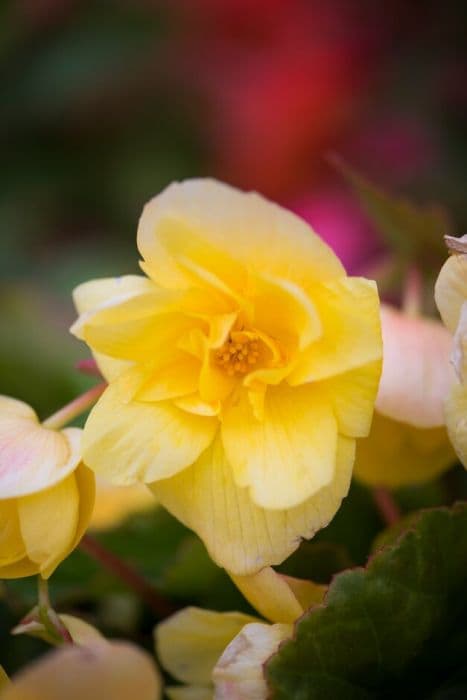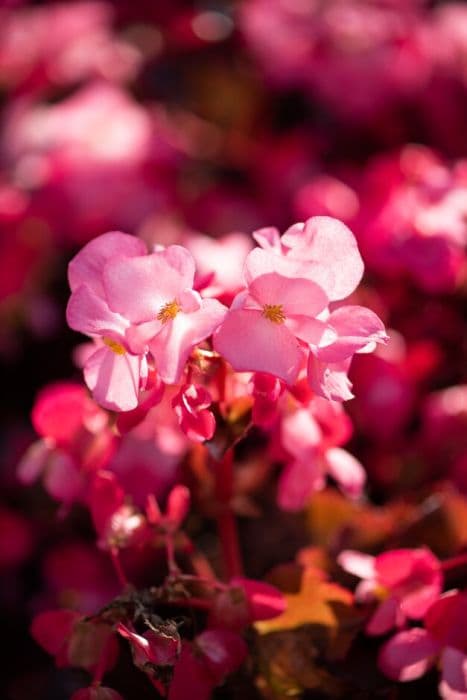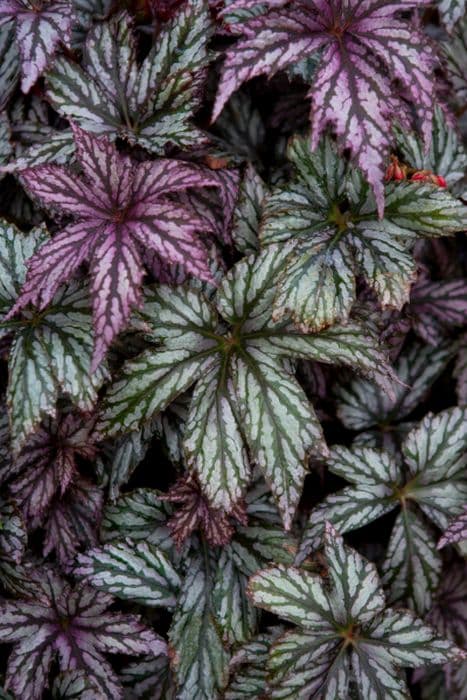Munchkin Begonia Begonia 'Munchkin'

ABOUT
Begonia 'Munchkin' is an attractive ornamental plant known for its unique and appealing features. The most striking aspect of the plant is its foliage, which often displays a lush and vibrant color palette. The leaves are typically fleshy and exhibit a range of shapes that could include being heart-shaped or more elongated with pointed tips. The texture of the leaves is another characteristic feature, where some may have a smooth surface, while others could be covered with fine hairs, giving them a fuzzy appearance. The color variation in Begonia 'Munchkin' leaves can be quite dramatic, with some leaves showcasing deep greens, while others may have a reddish or purplish undertone, often accentuated with contrasting veining patterns. It's not uncommon to see leaves with a combination of colors and patterns that make each leaf unique. Some Begonia 'Munchkin' may also exhibit a metallic or glossy sheen on their leaves, adding to their overall visual interest. Begonia 'Munchkin' also produces flowers, which are typically small and can come in different shades, such as white, pink, or red. These blossoms may appear individually or in clusters, adding a delicate touch to the plant's robust foliage. The flowers have a simple yet elegant form, sometimes boasting symmetrical petals that give off a soft, inviting vibe. The overall appearance of Begonia 'Munchkin' is one that exudes lushness and a compact form, making it a popular choice for indoor plant enthusiasts who appreciate its beauty and relatively easy care requirements. Despite its striking appearance, the plant's gentle demeanor allows it to blend in with a variety of decor styles, making it a versatile choice for adding greenery to living spaces.
About this plant
 Names
NamesFamily
Begoniaceae
Synonyms
Munchkin Begonia
Common names
Begonia 'Munchkin'.
 Toxicity
ToxicityTo humans
Begonias, including the Begonia 'Munchkin', contain insoluble oxalates which can be mildly toxic to humans if ingested. If someone eats a part of this plant, they may experience symptoms like a burning sensation in the mouth, tongue, lips, and throat. There may also be difficulty swallowing, vomiting, and nausea. Contact with the sap may irritate skin and eyes. In severe cases, if a large amount is consumed, it may lead to kidney stones due to the oxalate content.
To pets
Begonias are also toxic to pets due to the presence of insoluble oxalates. If a pet ingests a part of the Begonia 'Munchkin', they may exhibit signs such as oral pain, drooling, vomiting, and difficulty swallowing. In some cases, ingestion can lead to more severe symptoms like pawing at the face, decreased appetite, and lethargy. Immediate veterinary care is advised if a pet ingests any part of the plant.
 Characteristics
CharacteristicsLife cycle
Perennials
Foliage type
Evergreen
Color of leaves
Variegated
Flower color
Pink
Height
1 foot (0.30 meters)
Spread
1 foot (0.30 meters)
Plant type
Herb
Hardiness zones
10
Native area
Tropical South America
Benefits
 General Benefits
General Benefits- Easy to Care For: Begonias generally require minimal attention and 'Munchkin' is no exception, making it suitable for novice gardeners.
- Compact Growth: With its small stature, 'Munchkin' can fit well in limited spaces, such as small gardens or indoor apartments.
- Ornamental Value: The atypical foliage and flowers add aesthetic appeal to your garden or home.
- Long Blooming Season: Most Begonias, including 'Munchkin', have long flowering periods that can last from spring to fall.
- Versatility: Begonias can be grown indoors as houseplants or outdoors in containers or flower beds, offering flexibility in gardening choices.
- Colour Variety: 'Munchkin' can offer a range of colors in both leaves and flowers, enhancing the visual diversity of plant displays.
- Low Light Tolerance: They can often tolerate lower light conditions than many other flowering plants, providing more options for placement indoors.
- Drought Tolerance: Once established, Begonias tend to tolerate short periods of drought, making them ideal for climates with occasional water scarcity.
- Few Pests and Diseases: Begonias are relatively resistant to pests and diseases, reducing the need for chemical treatments.
 Medical Properties
Medical PropertiesThis plant is not used for medical purposes.
 Air-purifying Qualities
Air-purifying QualitiesThis plant is not specifically known for air purifying qualities.
 Other Uses
Other Uses- Begonia leaves can be used for crafting decorative impressions. Pressing a leaf into clay or plaster can create a unique and detailed pattern that captures the intricate vein structure of the leaf.
- The vibrant flowers of the plant can be pressed and included in scrapbooking or homemade paper to add natural beauty and a pop of color to the crafts.
- Due to their colorful appearance, begonias can be used as the natural dye source for fabrics and art projects, giving materials a unique and organic hue.
- Small begonia plants like 'Munchkin' are suitable for terrarium landscapes, offering a miniature garden scene encapsulated in glass where they can thrive in a controlled environment.
- Begonia leaves can be used to add aesthetic to candle-making by embedding the leaves within the wax, creating botanical-infused decorative candles.
- These plants can be used as educational tools in schools or workshops to teach about plant care, propagation, and the importance of horticulture.
- Begonia flowers can serve as an attractive, natural confetti at events, providing an environmentally friendly alternative to traditional paper or plastic confetti.
- The waxy texture of the leaves can inspire artists to create botanical drawings or paintings, using the plant as a live model for study and representation in visual art.
- Begonias can be used as a natural way to signify changing seasons in a theatrical set or movie scene, utilizing the plant's bloom cycle to denote time passing.
- With their compact growth, 'Munchkin' begonias can serve as living ornaments during holiday seasons, where small plants can be placed in festive pots or arrangements.
Interesting Facts
 Feng Shui
Feng ShuiThe Begonia is not used in Feng Shui practice.
 Zodiac Sign Compitability
Zodiac Sign CompitabilityThe Begonia is not used in astrology practice.
 Plant Symbolism
Plant Symbolism- Caution: Begonias often symbolize a sense of caution or warning due to their delicate and intricate blooms which can signify the need for careful handling of matters in life.
- Harmony: The balanced and symmetrical form of Begonias can represent living in harmony and striving for balance in one's personal affairs.
- Individuality: With their unique patterns and diverse varieties, Begonias can signify the importance of embracing one's individuality and personal uniqueness.
- Gratitude: Offering Begonias can be a way of expressing gratitude or appreciation toward someone, recognizing their kindness or efforts.
 Water
WaterFor the Begonia 'Munchkin', commonly known as wax begonia, it is recommended to water the plant when the top inch of soil feels dry to the touch. Approximately every 7 to 10 days should suffice, but frequency should be adjusted based on the plant's environment and the season. Use around 8 to 16 ounces of water per watering, ensuring that the soil is moist but not soggy. Avoid overhead watering to prevent foliar diseases, and use a watering can to direct the water to the base of the plant. During winter months, water less frequently as the plant enters a dormant period.
 Light
LightThe wax begonia prefers bright, indirect sunlight and should ideally be placed in a spot that receives dappled sunlight or in an area with filtered light. Direct afternoon sun can be too harsh and may scorch the leaves, so a location with morning sun or light shade is optimal. East-facing or north-facing windows are good locations for wax begonias.
 Temperature
TemperatureWax begonias thrive in temperatures between 60 and 75 degrees Fahrenheit but can survive in a range from 50 to 85 degrees Fahrenheit. These temperature ranges are crucial for healthy growth; if temperatures dip below 50 degrees, the plant may suffer from cold damage. To ensure the longevity of your wax begonia, maintain a consistent indoor temperature within the ideal range.
 Pruning
PruningPrune wax begonias to promote bushier growth, to remove dead or yellowing leaves, and to encourage more blooms. The best time to prune is in the spring, but light pruning can be done throughout the growing season as needed. Use clean, sharp scissors or pruning shears to make cuts just above leaf nodes, and be sure to remove any spent flowers to help conserve the plant's energy.
 Cleaning
CleaningAs needed
 Soil
SoilBegonia 'Munchkin' thrives in a lightweight, well-draining potting mix with a soil pH of around 5.5 to 6.5. A good recipe would be one part peat, one part pine bark, and one part perlite or sand. This combination ensures adequate drainage and a slightly acidic environment that Begonias prefer. Regularly check the soil moisture to maintain the ideal conditions.
 Repotting
RepottingBegonia 'Munchkin' typically requires repotting every one to two years to refresh the soil and provide more growing space. Repotting is best done in spring or early summer when the plant is entering its active growing phase. Be sure to use the recommended soil mix for the best results.
 Humidity & Misting
Humidity & MistingBegonia 'Munchkin' prefers high humidity levels, ideally around 50-70%. This can be maintained by placing the plant on a humidity tray filled with pebbles and water or using a humidifier. Avoiding excessively dry air is key to keeping 'Munchkin' Begonia healthy.
 Suitable locations
Suitable locationsIndoor
Keep in bright, indirect light and away from drafts.
Outdoor
Place in partial shade, protect from strong winds.
Hardiness zone
10-11 USDA
 Life cycle
Life cycleThe Begonia 'Munchkin', also known as Begonia, begins its life cycle as a seed, which germinates in warm, moist soil conditions, typically in spring or early summer. The seedling emerges and develops into a young plant with a set of true leaves, establishing itself over several weeks. As the plant matures, it forms a bushy structure with distinctive asymmetrical leaves and may produce blooms in various colors depending on the variety, often in the summer months. The Begonia 'Munchkin' reaches full maturity within a few months, where it continues to grow and can be propagated by stem cuttings or division to produce new plants. In the right conditions, Begonias can live for several years, but as perennials, they may become dormant or die back in colder seasons, to then regrow from the rhizome or tuberous rootstock when conditions improve. The plant's life cycle will eventually come to an end when it is unable to survive the environmental conditions, pests, diseases, or simply reaches its natural end of lifespan.
 Propogation
PropogationPropogation time
Spring-Summer
The Begonia 'Munchkin', often simply referred to as 'Munchkin' Begonia, is best propagated through leaf cuttings, which is a popular and reliable method for many begonia varieties. To propagate 'Munchkin' Begonia by leaf cuttings, you should ideally choose a healthy, mature leaf during its active growing season, typically in spring or early summer. Cut a leaf with a piece of its stem attached and place the cutting into a soilless propagation medium like peat moss or vermiculite, ensuring that the stem is buried and the leaf blade is laying flat on the surface. The environment should be warm (about 70°F or around 21°C) and humid, which can be achieved by covering the cutting with a plastic bag or cloche to maintain moisture. Roots usually develop within a few weeks, after which you can pot the new begonia plants into individual containers with a suitable potting mix.



![Begonia [Bonfire]](/_next/image?url=https%3A%2F%2Fplants-admin.emdemapps.com%2Fimages%2Fplants%2F%2Fimages%2F604b6124363f0.png&w=640&q=75)


![Begonia [Devotion]](/_next/image?url=https%3A%2F%2Fplants-admin.emdemapps.com%2Fimages%2Fplants%2F%2Fimages%2F604b58183573b.png&w=640&q=75)


